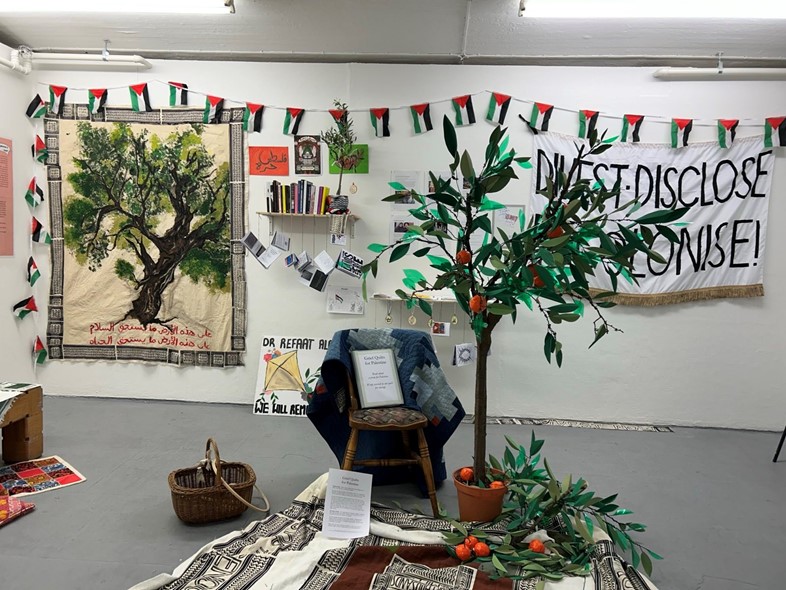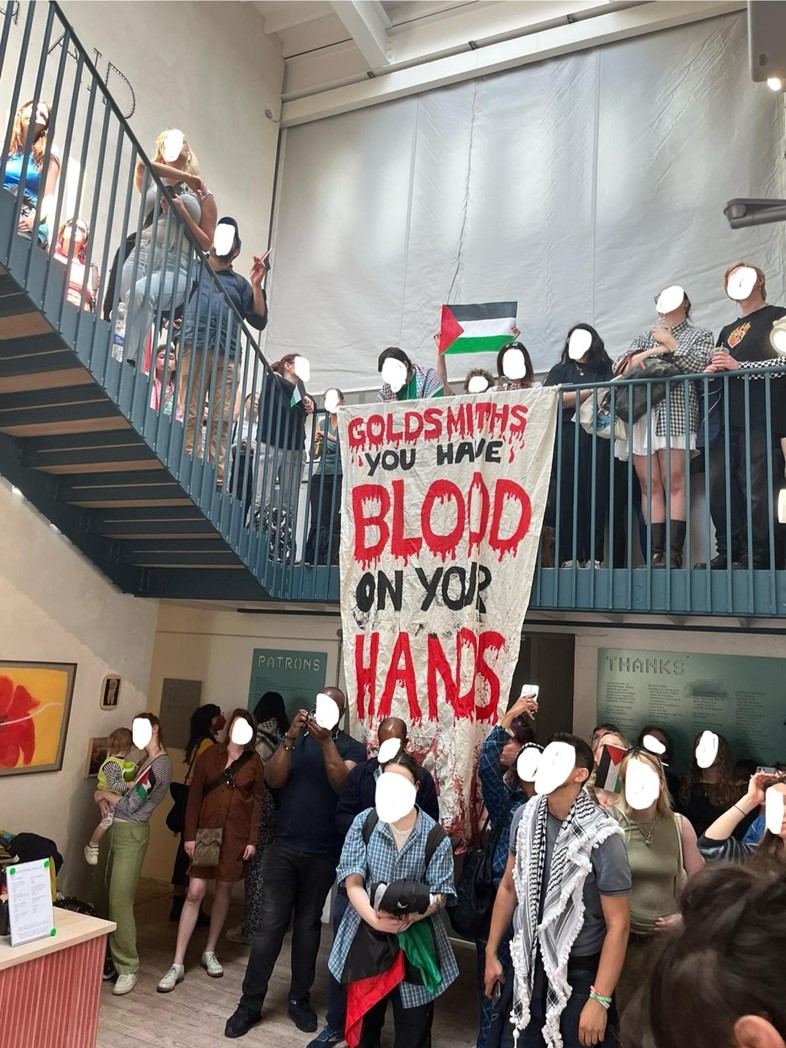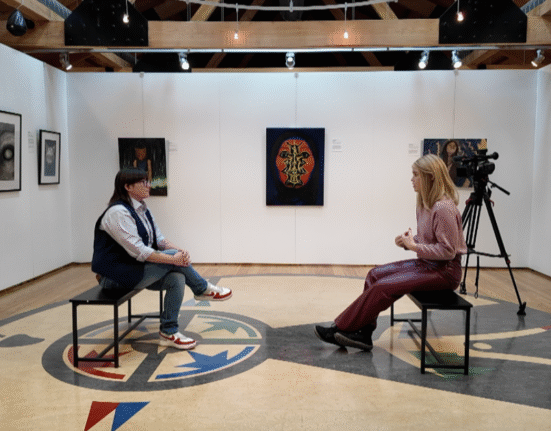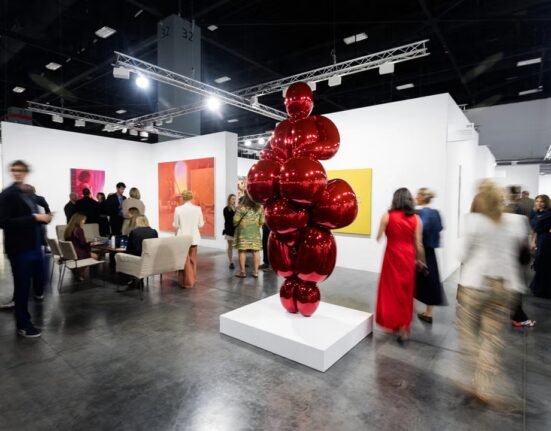UK university Palestine protests26 Images
The notion that art is inherently political and exists beyond its aesthetic value underscores the curriculum of most art schools in Britain, priming students with the impulse to engage critically with a range of socio-political issues in their personal lives and artistic practice. Across brochures and other marketing materials, universities pride themselves on this very “subversive” quality of their student body. One of the foremost art schools in the country, University of the Arts London (UAL) has branded itself as a social purpose university to the extent that the former chancellor proudly labelled the school “the world’s biggest trouble maker factory.”
So it is hypocritical – if not all that surprising – that these “trouble makers” across the country, who have rallied together to protest against their university’s complicity in the ongoing genocide in Palestine, are being met with a lack of communication and support from management on their demands on institutional divestment and boycotts.
For the students who have set up encampments on their campuses, protesting their tuition fees being invested in companies such as Elbit Systems that are manufacturing arms weapons for the Israeli Defence Forces, using art as resistance goes far beyond flowery language. Instead, it functions as a medium through which to express their politics, allowing them to demonstrate their frustration, grief and solidarity. Below, we look at how art students at UAL, Goldsmiths, and the Slade School of Fine Art are mobilising this aspect of art and visual culture, disrupting end-of-year degree shows, and escalating their actions to demand change on their campuses.
UNIVERSITY OF THE ARTS LONDON
In June, the student-run pro-Palestine committee UAL Students for Justice (UAL SJP) made headlines for protesting the highly awaited end-of-year BA fashion show at Central Saint Martins. Student protestors who had assembled on the balconies overlooking the runway dropped a patchwork banner embroidered with Palestinian flags and messages such as “Money for Jobs and Education, Not For War and Occupation”, drawing attention to Israel’s war crimes and UAL’s financial involvement in it. Students chanted demands for UAL to cut ties with Israeli textile company Kornit, as well as L’Oreal, which sponsors the BA and MA fashion shows and is on the BDS boycott list. “We are urging UAL to commit to ethical partnerships, establish scholarships for Palestinian students and defend the right to protest,” explains Nina*, a final-year student.
The occupied Central Saint Martins campus has been declared a liberated zone, where political education is at the forefront. “We’ve held several different workshops, such as one on Arabic calligraphy, hands-on embroidery sessions and film screenings from Palestinian filmmakers that centre around the relationship between art and liberation,” Nina says.
Alongside the arts programming, UAL SJP has organised protests across UAL’s campuses to coincide with degree shows. Over the last month, they have dropped a banner at the Chelsea College of Art undergraduate showcase and arranged a large-scale leaflet drop at the Camberwell College of Art degree show to protest against UAL’s partnership with the Bezalel Academy of Arts and Design, which provides emergency tailoring services through their students to the Israeli armed forces.

THE UCL SLADE SCHOOL OF FINE ART
Working alongside UCL Action For Palestine, Gemma*, a postgraduate student at the Slade School of Fine Art, gave up their degree show space to be used as a Palestine Zone. The space, curated and installed in less than a week, honoured Palestinian cultural heritage through educational posters, film screenings and a makeshift library with zines and handouts. An acrylic painting of an olive tree and a sculpture of the Jaffa orange plant was created by two students and backdropped the gallery space, serving as a visual reminder of the ecological destruction caused by the Israeli occupation. “The gallery became a representation of our collective grief and commitment to resist the erasure of Palestinian culture,” Gemma explains.
Another key element of the space was the community quilt made by Dr Jess Bailey, an associate lecturer in the History of Art department at UCL, with block-printed fabric supplied by Peckham Keffiyeh. The quilt was laid on the floor and surrounded by students and members of the public, who stitched the names of Palestinian poets and artists onto it. “Our community stitching on the quilt became a site of solidarity and reflection in the gallery, welcoming folks into the space and giving them a place to put their grief and rage,” Dr Bailey says.
In light of the extreme violence in Gaza, which has led to the destruction of the region’s education system, student representatives from UCL Action For Palestine expressed that the core theme of the show was the idea of “education as resistance.” Beyond this, the student organisers hoped to shed light on UCL’s financial complicity in the Israeli occupation, noting that “unlike the university’s publicly neutral stance on issues relating to Israel-Palestine, the university has very close partnerships with and receives considerable funding from some of the most destructive industries existing today, all of them making large profits from war, violence and colonial extractivism.”
In response to the actions undertaken by the students, a UCL spokesperson said: “Like many other universities, we have had a variety of demonstrations at UCL over recent months. We have been managing these in line with our commitment and legal duty to promote freedom of speech whilst also ensuring the safety and wellbeing of our whole community.”
As of July 15, the university has issued a ‘notice to vacate’ to the encampments on the campus after terminating discussions with student activists earlier this month on issues relating to divestment, condemning Israeli war crimes and honouring a well-respected alumnus and Palestine poet, Dr Refaat Alareer who was killed by Israeli air strikes on December 6.

GOLDSMITHS, UNIVERSITY OF LONDON
Over in southeast London, fine arts students at Goldsmiths staged a protest at their own degree show with a banner that proclaimed the students’ demands for Goldsmiths Management to divest from genocide. The student-led campaign group Goldsmiths for Palestine (GFP) also occupied the Goldsmiths Centre of Contemporary Arts opposite, and staged their own guerrilla exhibition, with specific attention given to the work of Palestinian artists.
Artwork on display included paintings by the Palestinian artist Malak Mattar, whose recent work, such as a series on women dying in labour due to a lack of medical supplies, is focused on the horrifying images that have been coming out of Gaza over the last eight months. Other artists in the show include Goldsmiths alumni Faissal El-Malak, whose film around folk songs and Palestine was screened in the occupied gallery space, and Xaytun Ennasr’s multi-media work that problematises ecological destruction caused by imperialism, amongst several others. Mati, an MFA student at Goldsmiths, shared how the show was developed in a few short days and expeditiously installed the evening before the preview, emphasising how they had to work with pre-existing fixtures to ensure management could not prosecute them for damage to the gallery.
As Mati suggests, a sense of urgency was palpable throughout the space but nowhere more apparent than the gallery’s entrance, which was covered by banners dripping in red paint declaring Goldsmiths CCA’s involvement in Israeli Apartheid. “We chose to occupy the CCA due to the existence of the ‘Candida and Zac Gertler Gallery’, which we have since renamed the ‘Walid Daqqa Gallery’, in memory of the Palestinian political prisoner who was murdered by the Israeli state this April,” explains Danna, on behalf of GFP. “The Gertlers actively supported Netanyahu’s political campaign and are involved in the continued murder of Palestinian civilians. One of our core demands to Goldsmiths is to cut all ties with the Gertlers and to revoke Candida’s fellowship at Goldsmiths.”
Apart from the initial banner drop and occupation of the CCA, student protestors were present across the Goldsmiths campus during degree show season, including a protest during the prize disruption ceremony. When asked how this impacted their experience, Maisie*, a graduating fine art student, said: “I always felt my work was very safe, and the action felt thought through to ensure it did not negatively impact students or seem inconsiderate to the hard work they put into the show. What more negatively impacted my degree show experience was the reaction some guests and Richard Noble (Head of the Art Department) had to the protests and the preemptive action taken by the university to combat any protest action.”
Over email correspondence with Dazed, the press team at Goldsmiths asserted that their priority throughout this conflict was to ensure that,” all students and staff are safe and supported.”








